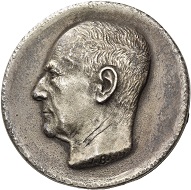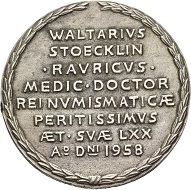by Alan S. Walker
March 15, 2018 – The Collection of the Stoecklin (Stöcklin) Family, was formed over a span of three generations and nearly 100 years. Many coins were not collected for their perfect quality but because they tell intriguing stories. But the story of the collection is a great story itself. Alan S. Walker tells it on occasion of Nomos’ e-auction Obolos 9 which is primarily devoted to the Roman and Byzantine part of the Stoecklin Collection.
The beginning of the collection in Austro-Hungary
The collection began with the family’s Great-Grandfather, Sebastian Ros. He was born in 1839 in Slovenia, at that time part of Austria-Hungary, studied civil engineering in Graz and Vienna, and gained considerable experience as a railway builder in the Slavic areas of the Empire. In 1874 he became an independent entrepreneur, and in 1881 moved to Belgrad, where he became well-known in professional circles; in 1887 he married the Slovene Antonia Strukelj, and both became Serbian citizens. Family lore has it that his collecting began from his abiding passion for history and from the coins, as well as pottery and other ancient remains, which were found during his incessant construction work laying rail lines throughout the Balkans. None of the preserved tickets seem to be in SR’s handwriting (most of those in this collection were written by his son-in-law, W. F. Stoecklin), but interestingly enough, one of the numismatic books that survive from SR’s library was his copy of the first edition of Historia Numorum, which was published in 1887 (the year of his marriage) and bears his signature (Nomos 14 lot 203). He apparently remained in Belgrad during World War I, despite the great destruction from von Mackensen’s recapture of the city in October 1915, and died there on 31 December 1917.
Walter Friedrich Stoecklin – coin enthusiast and physician
In any event, he very definitely inspired the passion for coins in his son-in-law. Walter Friedrich Stoecklin was born in Birsfelden (BL) in 1888 (the year after Historia Numorum was first published!); he studied to become a doctor and in 1913 joined the Red Cross. This was during the period of the First (8 October 1912-30 May 1913) and Second (16 June to 10 August 1913) Balkan Wars and he was sent to serve in a Serbian military hospital. There he met the attractive Jerica Ros, Sebastian’s daughter, who was working as a nurse: they married in 1914.
He returned with her to Switzerland and he began working as a doctor in Schönengrund (AR), where their son was born on 15 February 1915. In 1919 the young family moved to Amriswil (TG), where WFS became a much loved and well-respected ‘GP’.
He was something of a polymath: not only medicine and sciences, but also history and literature were central to his life; he loved travel to the lands of the ancient world: Southern Italy, Greece and Egypt; and he especially loved Greek and Roman coins. He became an active member of the Freie Numismatische Gesellschaft Zürich, and became friendly with all the collectors and dealers of the period: he knew the well-known Swiss collectors Walter Niggeler (1878-1964), August Voirol (1884-1967, a gynecologist like Pozzi) and was especially close to Dr. Louis Naegeli (1858-1951; his house was on Naegelistrasse in Zürich) from whom he acquired quite a few fine pieces. He bought from Bourgey and Florange in Paris; the Cahns, first in Frankfurt and then both as Münzhandlung Basel and M&M; from Hess in Luzern; Bank Leu, J. Dreifuss, H. Nussbaum and Sternberg in Zürich; P. Lederer in the Ticino; Luigi di Nicola and Santamaria in Rome; Ratto in Milan; Gaettens in Heidelberg; Peus in Frankfurt; as well as a certain Dr. Lesic of Belgrad, who sold him many pieces from the Nis Hoard. Many of the coins come from important collections of the past, such as those of Evans, de Nanteuil, Haeberlin, Jameson, Montagu, and Petrowicz; as well as from the collection in Gotha.
Coins with a story
WFS was basically a country doctor, and certainly did not have the same kind of assets as those of his friends, but loved the history behind his coins more than anything else. He did not concentrate on perfect coins, though he had some, but, rather, on nice coins, those that he could show to his friends and colleagues, and which had stories to tell. As can be seen from the coins in this catalogue, he managed to acquire coins that are attractive, interesting and often exciting; they are also truly accessible to virtually every serious collector.
Walter Mirko Stoecklin was the last coin collector in Stoecklin family. His death in 1981 put an end to the collection.
The end of the Stoecklin Collection
WFS died in October 1975 and the collection went to his son Walter Mirko Stoecklin. He graduated in medicine from the University of Basel and took over a specialized Ear, Nose and Throat practice in Winterthur in 1950. WMS had already begun collecting with his father as a boy: Voirol gave him a book on coins as a belated wedding present in 1948 (Nomos 14 lot 207) and a good number of coin tickets are in his handwriting. His tastes seem to have been as universal as his father’s: one purchase that was clearly his was the splendid double-sestertius of Trajan Decius that he bought from the notorious Robert Hecht in 1961 (Nomos 14 lot 419). His sudden death in 1981 put an end to the collection.
In the Obolos 9 online catalogue you will find many coins from the Stoecklin collection.
Alan S. Walker presents a selection of them and tells their fascinating story.
On the Nomos website you will find more information on Nomos AG and Alan S. Walker.





